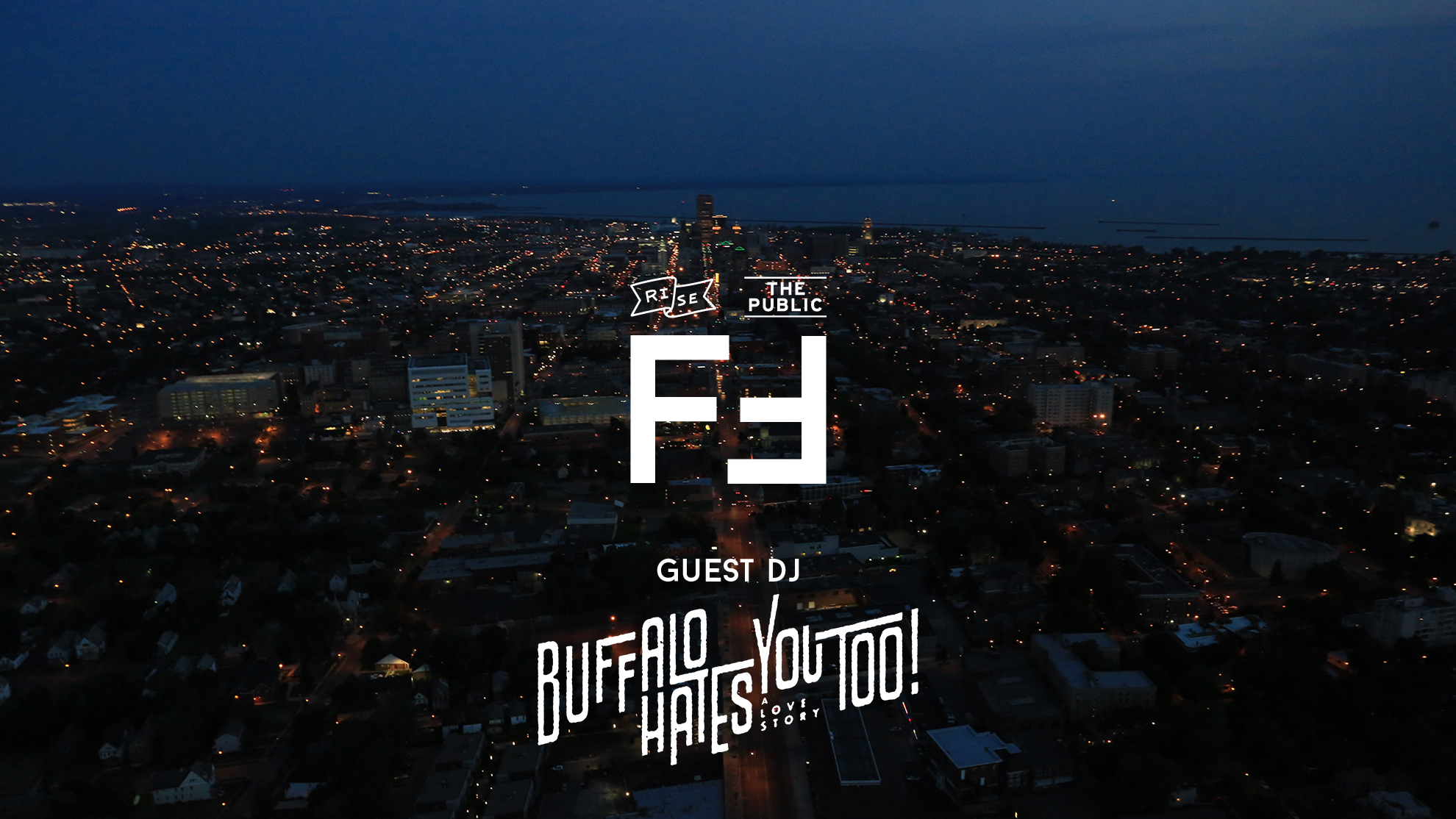It’s time to do what’s right and transform our city
Since the Humboldt Expressway was installed in the 1960’s and 1970’s, economic and public health has declined in its wake. Numerous policies including redlining and disinvestment have contributed to the challenges the 20 or so different neighborhoods that make up Buffalo’s East Side face, but none more obvious than the destruction of the largest parkway in Frederick Law Olmsted’s park and parkway system in Buffalo, the only one of its kind in the world.
2023 is not the time to reinforce our mistakes of the 1960’s. The state and city must right a historic wrong, and invest in and protect our neighbors in the East Side. If we really want to help our neighborhoods still reeling from the tragedy of 5/14/22, among many actions we can take would be to fill in the expressway end-to-end, and pass sweeping legislation that will protect homeowners and renters from gentrification for years to come.
The worst decision
An obvious effect of the Kensington Expressway (from I-90 to Elm/Oak corridors) construction is that over 70% of the businesses on Buffalo’s major arterials closed within ten years of its completion. Auto traffic was diverted away from Kensington, Genesee, William, Clinton, Main, Walden/Best, Sycamore, and Broadway. Commuters and local residents opted for the high-speed, six lane sunken roadway rather than those arterials, and businesses lost their customers. Also obvious are the high levels of asthma and other health complications documented in the neighborhoods surrounding the expressway due to concentrating the pollution once spread across those eight arterials into one corridor.
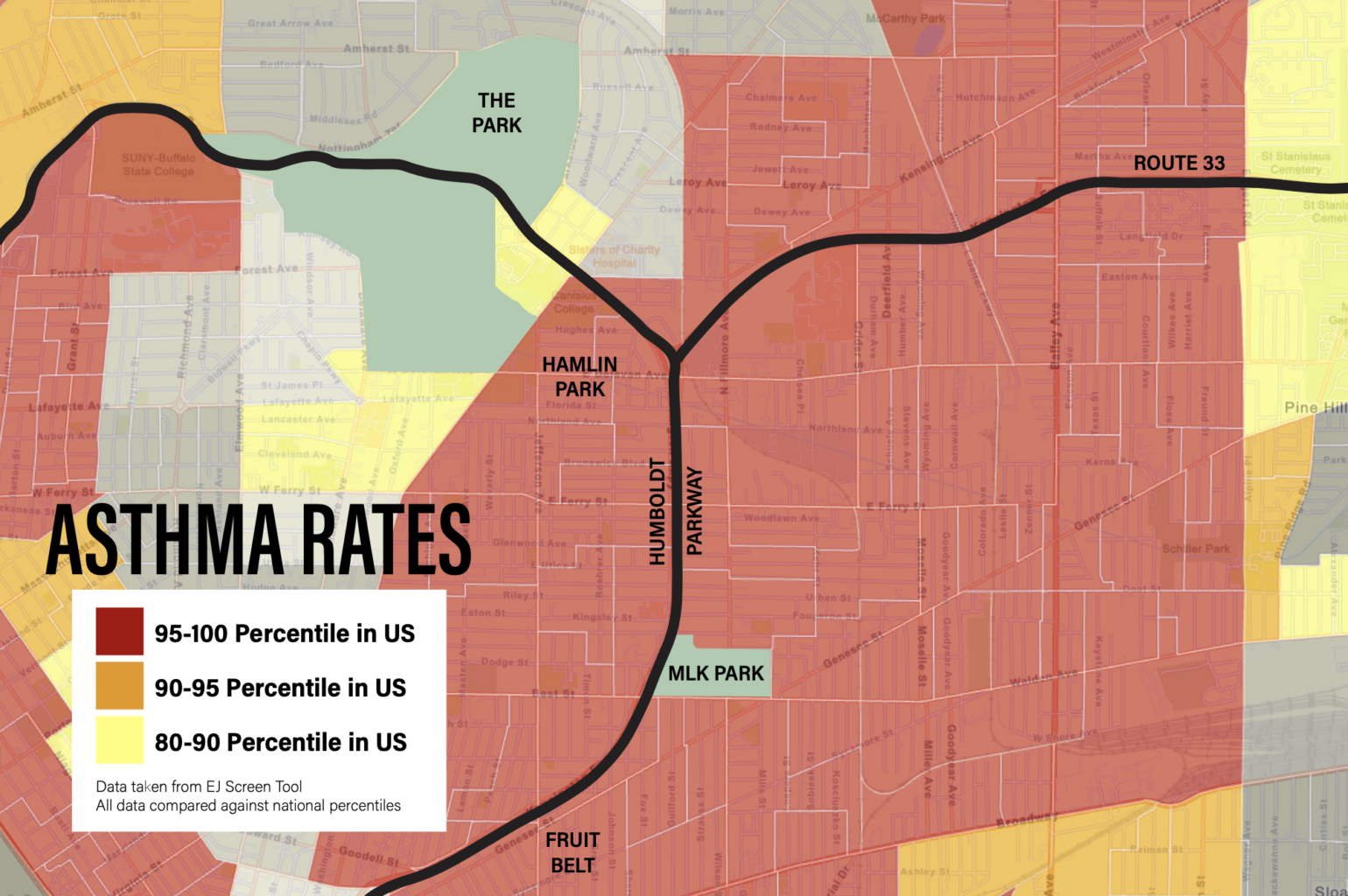
–
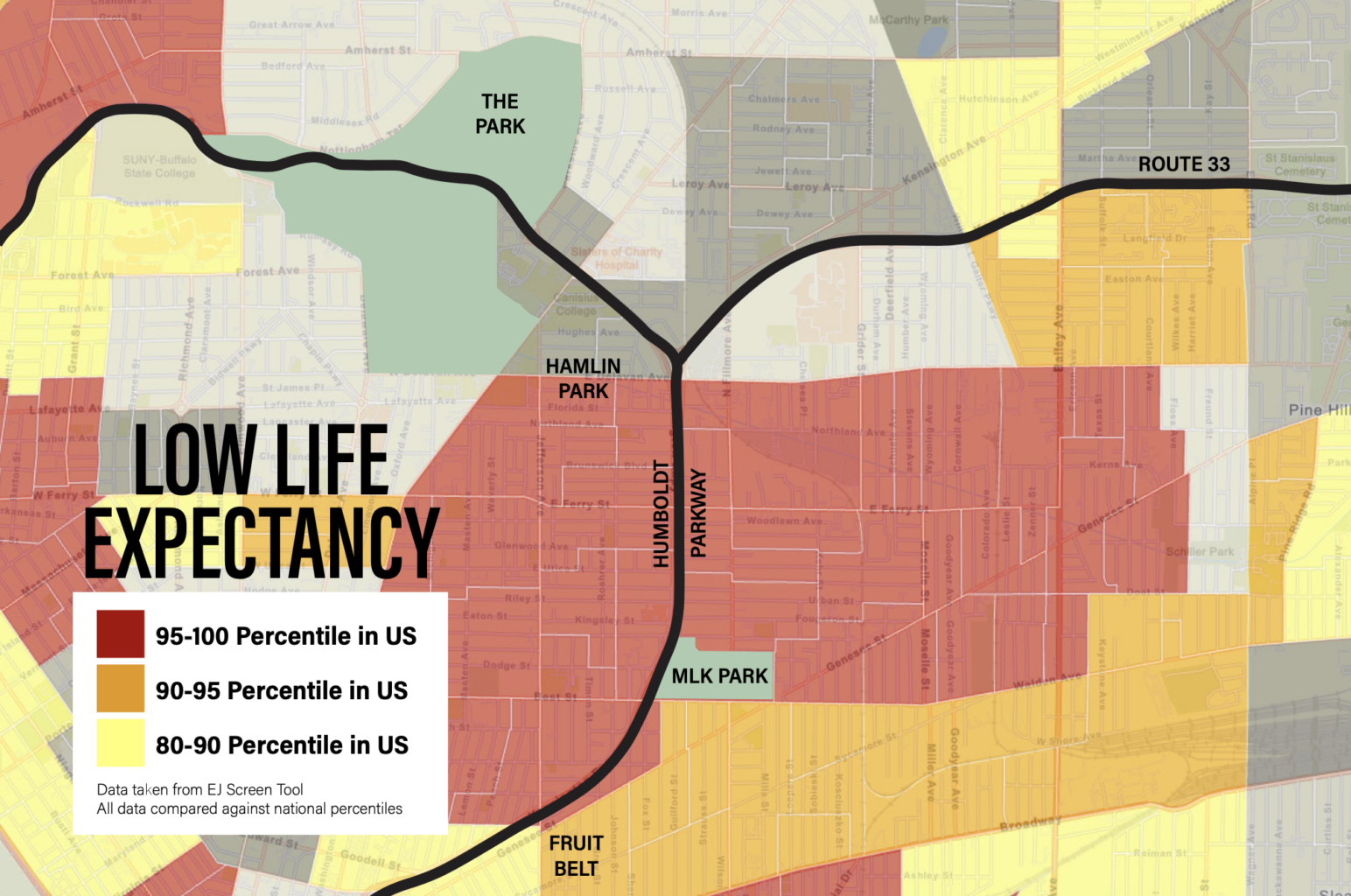
–
For years, members of Restore Our Community Coalition (ROCC) petitioned state lawmakers to reconnect their once bustling community, cut in half when the expressway was installed. In 2013, ROCC founding member Stephanie Barber Geter said, when referring to local and state leadership at the time of the original construction, “They said ‘Hey. This is progress!’
“How is it progress? How do you just cut right through a neighborhood, and one side gets destroyed because of it, and the other side barely holds on? It’ll make you cry.
“You’ll say ‘Well, what in the world happened?’
“Every public record shows us there were public votes, there was public hearings where people said, ‘Don’t do this. This is really going to destroy neighborhoods.’
“And they did it anyway,” she lamented when interviewed for John Paget’s documentary, Buffalo: America’s Best-Designed City.
By the time plans were in motion, and construction began, the neighborhoods surrounding Humboldt were majority Black-owned. The expressway didn’t just destroy a beautiful parkway, the most beautiful in Buffalo’s entire system, it also demolished hundreds of homes in the Fruit Belt neighborhood, displacing thousands of people.
There was a planned extension to go through Allentown and the lower west side all the way to I-190, but the majority white residents there also said no. To that audience, the state listened and canceled construction plans.
Repeating history
Now that the walls (which were coated in asbestos upon construction as a waterproofing mechanism) of the expressway are visibly crumbling, the NYSDOT is in a hurry to tear them down and rebuild them. The state worked with ROCC to develop a plan to reconnect the community by placing a cap over a stretch of the expressway, roughly ¾ of a mile between E Ferry Street and Best Street. The plan will cost over $1Billion right now, with no guarantees those prices will not balloon throughout the planned four to five years of construction.
There will be about 36” of soil where trees will be planted (the DOT has no plan for who will maintain it and make sure the trees grow. The city’s resources are already stretched, and this is not a restored parkway, so it wouldn’t be Buffalo Olmsted Parks Concervancy’s responsibility either. Beneath that soil would be a membrane. What if it only lasts 20 years? Or 50? Will the entire structure, and all of its trees, need to be torn out and rebuilt at the cost of another few hundred million taxpayer dollars? We don’t know. We do know that the bridges over the current expressway have already exceeded their life expectancy and must be replaced within this project, so there’s little doubt that whatever is planted on the cap will inevitably need to be destroyed at some point so the membrane can be rebuilt, adding to the fears of ever growing maintenance costs associated with this project and who will bear these costs.
Below the cap, in order to allow cars and trucks to have as much space as before, the bedrock will need to be blasted to pieces in order to dig 4-17 feet further down, and adjacent control rooms will be installed even closer to property lines. This has residents and the preservation community concerned over gas and water supplies to adjacent houses, sewer lines and foundations cracking. The NYSDOT has not offered any guarantees to the adjacent homeowners that damage to their property during construction will be covered. A 2012 concept design study mentioned concerns of release of radioactive gasses from the bedrock blasting, but in 2023’s Design and Development Research (DDR) and hasty Environmental Assessment (EA) process, no more mention was made.
NYSDOT is pitching this to the community as Phase 1, where a future phase would then connect MLK Park to Delaware Park. This is a false promise. Not only is the state’s budget predicted to balloon dramatically over the next five years, making another project of this scale nearly impossible to fund, but the Scajaquada Creek is also buried just below the surface of the expressway north of E Ferry Street. Unless the state plans to tunnel the entire expressway below the creek at an extraordinary cost, the dream of reconnecting MLK and Delaware Parks, in accordance with Olmsted’s vision, is all but dead.
Finally, by the NYSDOT’s own admission, the air quality at both ends of the tunnel will be worse. There are schools, community centers, churches, and of course people’s homes within the area already experiencing adverse effects, and now those at either end of the tunnel will see their air quality drop even lower when New York State constructs this car-centric project right through their front lawns – in the 2020’s when other cities are tearing out their urban highways. Despite the 2021 constitutional amendment that guarantees New York citizens the right to clean air and clean water, and a healthful environment, despite the 2019 Climate Leadership and Community Protection Act, and despite declining numbers of daily commuters as remote work emerged after COVID, the NYSDOT is pushing forward to maintain the vehicle level of service, their only mandate, at the cost of surrounding citizens’ health, and of all New York State taxpayers.
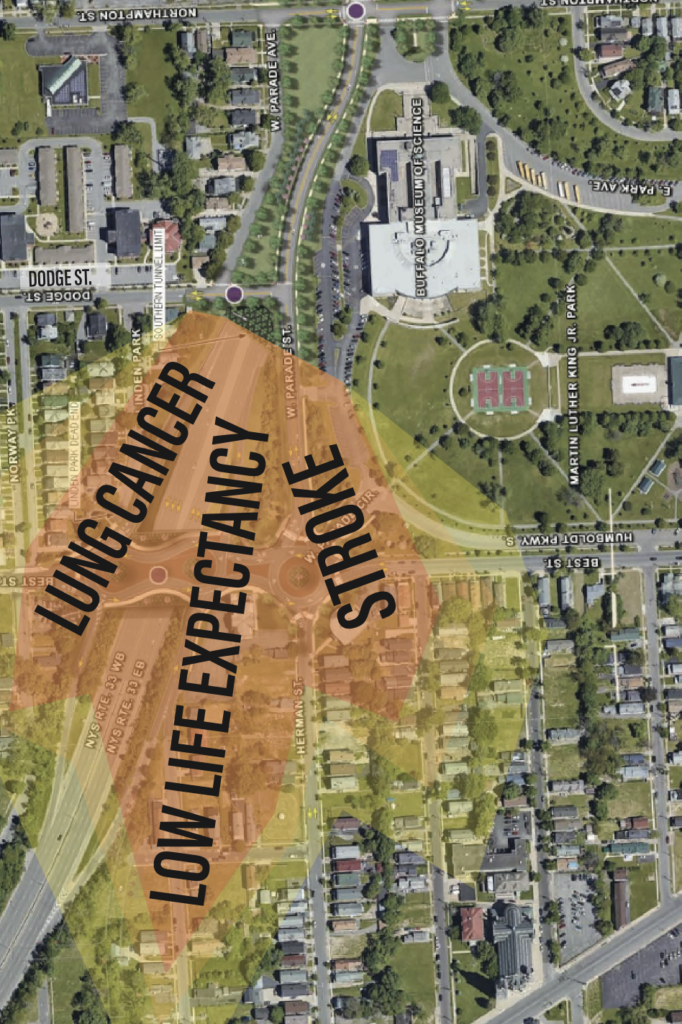
–
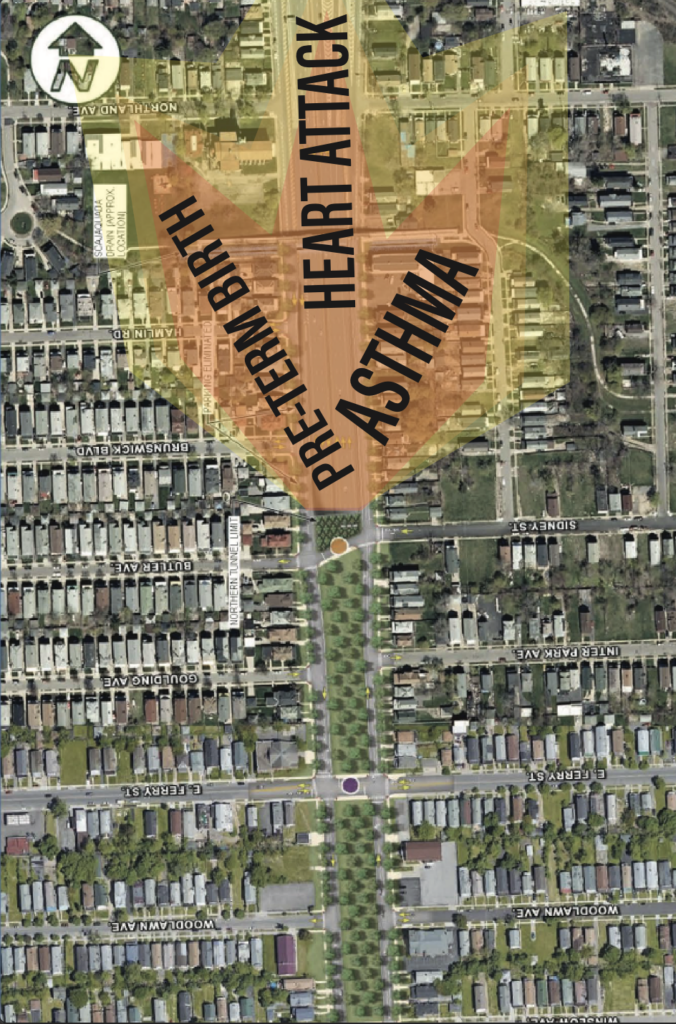
–
What an incredible, world-class city Buffalo could become if we just did the right thing.
Since the NYSDOT’s plan materialized, The East Side Parkways Coalition has risen up as the leading advocacy organization for those citizens who will be most acutely affected by this project. They’re led by adjacent neighbors and community groups, and the coalition also features business owners, architecture and planning students, transit advocates, preservationists, taxpayer advocates, artists, and now The New York Civil Liberties Union who penned a scathing rebuke to the NYSDOT’s process and how it has treated adjacent residents.
“This entire thing has been a project without a plan. There’s no concern for the children and adults who live here. Five years of construction just a few feet away from my front porch. Five years! And for what? So that cars can drive fast and make the air my family breathes worse than it already is? No. This project isn’t inevitable. We just need to put the health of this community ahead of NYSDOT’s desire to keep this highway in place for three or four more generations,” said Terry Robinson, a Humboldt Parkway resident who has been leading the East Side Parkway Coalition’s efforts. Mr. Robinson also just filed a lawsuit against the state on Wednesday 12/13/23.
The main calls to action are for a better process. So many questions asked by residents have gone unanswered. The ESPC is asking for an Environmental Impact Statement to be completed, which is a year-long exhaustive study of all NYSDOT’s claims, as well as of the outcomes of the many alternative options. The people living near this project deserve better than the current process that’s moving as fast as the cars that drag race along the Humboldt Expressway every night.
When the members of the Scajaquada Corridor Coalition pushed back against the NYSDOT and got the planning process for the 198 handed over to the Greater Buffalo Niagara Transportation Council, the GBNRTC had three goals identified through the SCC’s public engagement process which included; 1) Enhanced equity and inclusive economic development; 2) Replenished parks, parkways, waterways, and places; and 3) Effective local and regional mobility. Then design scenarios were evaluated against these goals achieving a preferred plan to advance which is not solely focused on moving vehicles. The NYS DOT’s only goal for the Humboldt Project is to maintain or improve vehicle level of service.
ESPC is also calling for the entire expressway to be filled in entirely, which is a plan that NYSDOT briefly included within 10 possibilities for the future of the expressway, which they claimed would cost $250M which would save the state $750M initially, and hundreds of millions more dollars in long-term maintenance costs.
For decades, residents of the East Side have been told that real change is coming. That we understand the challenges its residents face. That we’re going to do things differently.
For decades, that change hasn’t arrived. And now, the state is calling this $1B project a once-in-a-lifetime investment in the East Side that will only partially cover the expressway, make toxic air pollution worse, and put adjacent properties at risk of damage.
It is an investment. An investment in reducing commute times to and from the suburbs, entirely at the expense of the mental and physical health of affected neighbors.
After the tragedy of the racist terror act on 5/14/22 at the Jefferson Avenue Tops (three blocks from the expressway), when state and federal officials flocked to Buffalo making more of the same promises, it should have gone differently, and it still can.
Real change, to help heal a wounded East Side, would be to call for the immediate and full restoration of Humboldt Parkway. Fill in the expressway from Agassiz Circle to Best Street, and turn the surface-level roadway through the Fruitbelt into an extension of that parkway. Plant trees that will last 100+ years. Plant community gardens to utilize that green space while the trees grow. Turn Humboldt Parkway into a unifying community center with farmers markets, concerts, barbecues, art installations, walking, rolling, and biking. Improve public transit. We can afford it all. If we’re willing to spend $1B on a partial cap, then we have the means to spend $250M to fill it in instead.
Next, the city and state should pass sweeping legislation to protect homeowners and renters from gentrification. We’re talking about restoring the grandest parkway in the system, creating one of the most beautiful stretches of neighborhoods in our city and region. Those who have stayed all this time should not be pushed out. Smart Growth America has laid out multiple strategies to use as guidelines already, including help for owners of single family homes rehabilitating their homes, pools of funding to acquire or rehabilitate affordable housing so that renters may stay, property tax relief, community land trusts, down payment assistance to qualifying demographics, legacy business programs, right to counsel, rent stabilization and so much more. [Smart Growth America’s recommendations: Page 1. Page 2.]
The money designated for construction, despite NYSDOT’s claims, can and should be reallocated into enhancing safety and traffic technology along Buffalo’s many arterials. Economic development would follow as traffic returns and businesses reopen. We would see community health improve as thousands of trees grew, and pollution was no longer concentrated within a single corridor.
Buffalo would be on its way to restoring its crown jewels, Olmsted’s park and parkway system. That design is worthy of UNESCO World Heritage site status. It was never intended to be a six-lane highway. When we talk about making this city a more attractive place to live and visit, what can make us more unique in all of North America, and the entire world, than restoring the most incredible concept of a city that is within a park.
Buffalo would no longer sacrifice its own citizens’ health and economic opportunity in order to save commuters from other municipalities a few minutes in their cars each day. With the money saved, we could even build a train line out to the airport and its surrounding retail and industrial centers to create even more economic opportunity for residents across our region.
When this neighborhood-led opposition effort began, it was the Buffalo Olmsted Parks Conservancy that wrote one of the first public letters from a prominent community organization which appropriately criticized NYSDOT’s plan and process. It galvanized all involved and caught the attention of the NYCLU.
Newly appointed BOPC Executive Director Catie Stephenson said, “I just keep thinking that if the conservancy existed when the expressway was first constructed, we would have fought alongside the community to prevent the destruction. There could have been a national call from landscape architects and Olmsted scholars to protect the Parkway. I’m sure some people would have gone so far as to chain themselves to the trees to prevent losing them. But the Conservancy was not around then. But we’re here now and we will advocate to make sure the community has well-informed options to choose from.”
Let’s do the right thing for the people who have been harmed by decades of poor decisions and policies. We’ll see our city take a step closer to restoring its former glory. A strong, robust city at the center of our region is in every Western New Yorker’s interests.
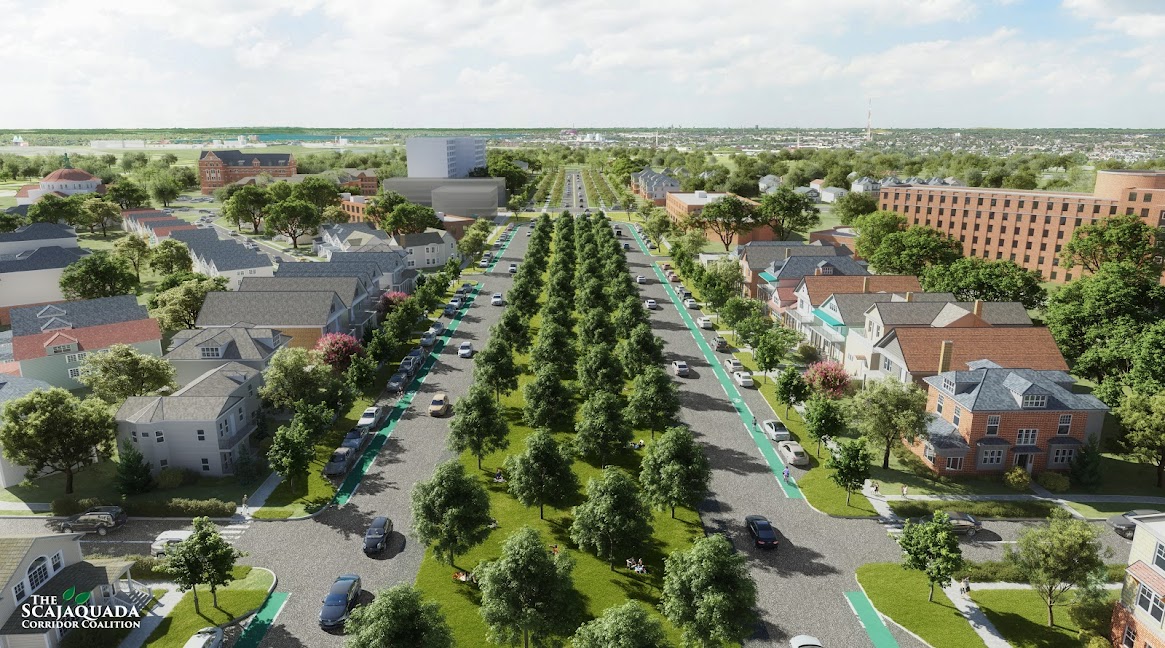
The GBNRTC worked directly with affected communities to develop their process and proposals for the 198’s future. This Humboldt Expressway decking project has been led entirely by NYSDOT, despite residents asking for the GBNRTC’s involvement.


